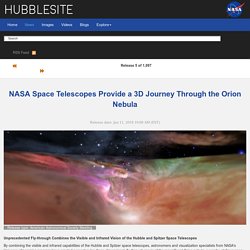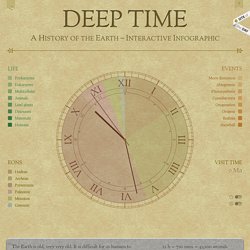

National Library of Virtual Manipulatives. HubbleSite: News - NASA Space Telescopes Provide a 3D Journey Through the Orion Nebula. Astronomers and visualization specialists from NASA’s Universe of Learning program have combined visible and infrared vision of the Hubble and Spitzer space telescopes to create an unprecedented, three-dimensional, fly-through view of the picturesque Orion Nebula, a nearby star-forming region.

Viewers experience this nearby stellar nursery “close up and personally” as the new digital visualization ferries them among newborn stars, glowing clouds heated by intense radiation, and tadpole-shaped gaseous envelopes surrounding protoplanetary disks. Using actual scientific imagery and other data, combined with Hollywood techniques, a team at the Space Telescope Science Institute in Baltimore, Maryland, and the Caltech/IPAC in Pasadena, California, has created the best and most detailed multi-wavelength visualization yet of this photogenic nebula. The fly-through enables people to experience and learn about the universe in an exciting new way.
PlanetQuest Historic Timeline. Moonbase Alpha on Steam. About This Game NASA has once again landed on the lunar surface with the goal of colonization, research, and further exploration.

Shortly after the return to the Moon, NASA has established a small outpost on the south pole of the moon called Moonbase Alpha. Utilizing solar energy and regolith processing, the moonbase has become self-sufficient and plans for further expansion are underway. In Moonbase Alpha, you assume the exciting role of an astronaut working to further human expansion and research. Returning from a research expedition, you witness a meteorite impact that cripples the life support capability of the settlement. Key features: Team up with your friends... Home and City. Welcome to MarsQuest Online! ESB Ampville: The Electric City. Switch Zoo - Make New Animals. Wild Games - Defenders of Wildlife.
Curiosity Cabinet. Over the past 25 years I have accumulated a collection of various gizmos, devices, toys etc. which to me are excellent examples of scientific principles or things that you look at and you say "That's impossible!

" except it's staring you in the face. In the hope that others may also find them interesting and with the help of two undergraduates, Jacy Lundberg and Omar Khan, we have created videos of many of the items in the collection. In many cases we have tried to include explanations of how they work or references to where one can find this information. Jacy and Omar are currently seniors in the Boston College pre-medical program.
Omar is from Portland, Oregon and Jacy is from Los Angeles, California. In the olden days some people assembled what were known as curiosity cabinets. Solar System Scope. Widgets/windenergy/index.html. Miami Museum of Science-pH Panel. The Planets Today : A live view of the solar system. Physics Activities - Molecular Workbench Showcase. Science. ConvexConcaveLens. 100,000 Stars. Magnifying the Universe. Embed this infographic on your site!

<iframe width="500" height="323" scrolling="no" src=" frameborder="0" allowfullscreen></iframe><br />Copyright 2012. <a href=" the Universe</a> by <a href=" Sleuth</a>. The above is an interactive infographic. We have also developed a complimentary poster that you can view here: Sizes of the Universe poster. If you're technically inclined, here's a look at the references we used to construct these infographics: Facts About The Universe. Introduction: This interactive infographic from Number Sleuth accurately illustrates the scale of over 100 items within the observable universe ranging from galaxies to insects, nebulae and stars to molecules and atoms. While other sites have tried to magnify the universe, no one else has done so with real photographs and 3D renderings. How To Use: Step 1:To experience this interactive infographic in full screen (our recommendation) click the "Full Screen" button in the top right corner of the infographic.
Credits: Science Interactives. PhET: Free online physics, chemistry, biology, earth science and math simulations. Deep Time : A History of the Earth - Interactive Infographic. Life on the planet started astonishingly early.

The first living organisms, in the current model of evolution, are thought to be Prokaryotes1. The oldest known fossilised prokaryotes have been dated to approximately 3.5 billion years ago, only 1 billion years after the formation of the Earth's crust. Eukaryotes2 are more advanced organisms with complex cell structures, each of which contains a nucleus.
Although incredibly hard to determine their origin, they are thought to have developed 1.6–2.1 billion years ago, although some research2 suggests eukaryotes being present even earlier than this. Around 1.1 billion years ago multicellular3 organisms are thought to have started to develop, most likely similar in form to plants such as green algae. 200 million years later true multicellularity had also evolved in animals similar in nature to today's sponges, which are organisms which can reassemble themselves. The genus Homo gave rise to modern humans8, Homo sapiens, us. Be The Beat. The Scale of Life.